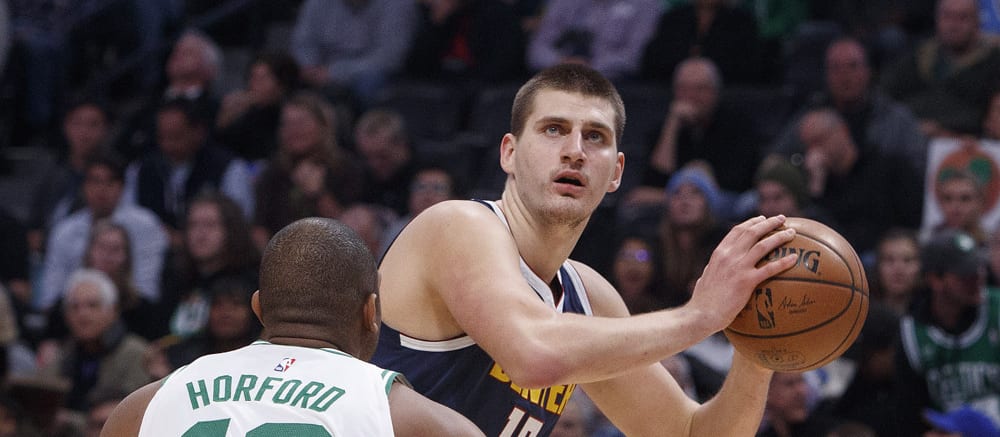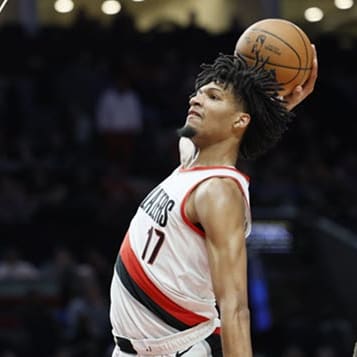This article is part of our Category Strategy series.
Congratulations! You're doing a category-based fantasy league. Don't tell your friends who play in points leagues that I said this, but category leagues are much more fun.
Actually. Do tell them. Get them to change their leagues, too.
Anyway, now that you're playing in a category-based league, what strategies do you need to know? How can you best prepare yourself for domination? We're here to help.
First, as always, is know your league's settings.
8-cat, 9-cat, or something else?
Almost all category leagues are either "8-cat" (eight default categories) or "9-cat" (nine default categories). The eight default categories are points, rebounds, assists, steals, blocks, threes, FG% and FT%. Turnovers are the ninth default, and the only difference between 8-cat and 9-cat leagues.
Generally speaking, the fantasy community has been shifting towards the use of 8-cat over 9-cat in recent years, but 9-cat remains the default setting for Yahoo!, and both settings remain very common.
Some analysts recommend ignoring turnovers on draft day, even if you're in a 9-category league. I think that's going a step too far, but I agree that they should not be a primary consideration.
A few themes to remember if you play in an 9-cat league: James Harden and Russell Westbrook are turnover machines; rookies tend to be particularly turnover prone, especially rookie ball-handlers; catch-and-shoot specialists (think Danny Green) and big men who don't pass (think Hassan Whiteside) tend to see the biggest boosts in 9-cat value.
Occasionally, league commissioners experiment with some other category options. Some of the most common alternatives are double-doubles, triple-doubles, splitting offensive and defensive rebounds into two categories, or changing the way field goal efficiency is measured (i.e. counting made field goals, made free throws, eFG%, TS%, or some combination thereof). If you play in one of these leagues with atypical categories, the most important thing to remember is that most fantasy advice is not tailored for your leagues. There is still a lot to gain and a lot to be learned from articles, tweets, podcasts, etc, but remember that all of that advice assumes that you're playing in either 8-cat or 9-cat.
The easiest example of how advice can change for unusual league settings is probably the cases of Nikola Jokic and Russell Westbrook. You're unlikely to find anyone who says Jokic should get picked before sixth overall this season, and Westbrook is well outside the first round in 9-cat. But if you are in a league that awards points for double-doubles and triple-doubles, Jokic becomes an option for the first overall pick and Westbrook becomes an easy top-10 pick.
Weekly vs. daily lineups; IR spots
This isn't special to category-based leagues, but fantasy managers need to know whether they set lineups every day or once a week and whether they have an IR spot. Managers in weekly lineups leagues or leagues without an IR spot need to be more cautious on draft day. Someone like Joel Embiid, who is likely to miss a lot of games for "load management", does more damage in a weekly lineups league than a daily lineups league – in a daily lineups league, at least you can start someone else those games. Similarly, Chris Paul is still a fantasy force, but he usually misses a few weeks each season due to injury. That injury is easier to wait out if your roster has an IR spot. Both players are still valuable in weekly or non-IR leagues, but if you've already drafted Paul in a non-IR league, maybe take a pass on Kevin Love a few rounds later.
Roto vs. Head-to-Head
This is the big one. In an H2H (head-to-head) league, you face off against one team per week, your categories against your opponent's. In H2H leagues, the teams with the best records qualify for the playoffs, and the champion is the winner of the playoff tournament. In roto (short for rotisserie, a formant named – oddly enough – for a long-defunct French restaurant in Manhattan), teams compete against the entire league over the course of the season. In a 12-team league, the leader in a given category gains 12 points, second place gets 11, third place gets 10, and so on until last place gets a single point. The champion is the team with the most cumulative points on the final day of the season.
The most important difference between H2H and roto is that punting (deliberately ignoring one or two categories, so that you can build an extra strong team in the remaining categories) usually leads to different results. In H2H, a well-crafted punt build can be highly effective. In fact, I actively recommend the strategy. However, in roto, punting successfully is much harder.
Let's get into specifics, just so you can fully appreciate how difficult it is to win a roto league while punting. In a 12-team nine-category league, the winning team will probably score at least 85 points, if not more. If you're starting the season by accepting just one point in a category, then you need to average 10.5 points across the other eight categories to score 85 points -- 10.5 points is what you get for finishing tied-for-second in a category. It's not impossible, but it is very, very difficult.
Categorical scarcity
You could write books going into the nuances of categorical scarcity, and the topic is a primary focus of my Numbers Game column. That said, here are the key basics.
Very scarce
Blocks and assists are the scarcest categories, and the two hardest to find after the draft. Most of the leagues' assists come from the top point guards, with a few notable exceptions – Nikola Jokic, LeBron James, Draymond Green, and a few others. All of the non-point-guard assists leaders are going to get drafted, and most of them will go in the first couple of rounds. When a point guard becomes worthy of acquisition off the waiver wire, they rarely are high-impact passers.
Similarly, there will be some shot-blocking big men who emerge off waivers as the season rolls along, but, as with assists, those players rarely block enough shots to make a major impact. As with assists, most of the best shot-blockers will all get drafted in the first couple of rounds.
Less scarce
Rebounds and three-pointers are on the opposite end of the spectrum, especially as the league continues to attempt more and more threes each season. While the top 10 or so rebounders stays pretty steady from year to year, there are always several big men who emerge early in the season as reliable sources of boards. Furthermore, as big men get hurt, their backups usually step in and provide a decent facsimile of the starter's rebounding load.
Threes are a slightly different story, but the results are the same. As the total number of threes has increased, finding quality three-point shooters later in drafts has become easier and easier. Every year, a few players emerge as semi-surprising additions to the threes-per-game leaderboard. Perhaps more importantly, due to the streaky nature of long-range shooting, managers who remain active on the waiver wire can usually find a few players going through a hot streak and averaging several made threes per game. While the near-constant presence of these waiver-wire pickups are helpful, there is still a lot of value in drafting potential league-leaders like Bradley Beal or Buddy Hield. Rather, the depth of the category should impact your decisions later in drafts.
Points
Points are tricky. On the one hand, all the best scorers are going to get drafted early. Unless you are deliberately punting the category, you'll probably need to draft at least one 20-plus-point scorer early to stay competitive.
On the other hand, points are often overvalued by fantasy managers. Low scorers like Brook Lopez and Larry Nance always get drafted much later than they should – they finished last season ranked 31 and 55, respectively, but currently have average draft positions (ADP) of 83 and 85. High scorers get picked up off waivers much quicker, even if they provide little value in the other categories. Furthermore, as NBA offenses have changed, there are more high scorers available in the later rounds of drafts than ever before.
Points do become available on waivers throughout the season, but most of the time, it's only players who score between 13 and 18 points. Those guys can help, but, here too, waivers are unlikely to bail you out if you missed on this category on draft day.
Steals
Steals are always available on waivers. The problem? Most of those thieves don't provide enough help in the other categories to be worth rostering. That means that managers in daily lineups leagues can provide meaningful help off of waivers, especially late in the week in a close H2H matchup, but that managers in weekly lineups leagues will have a harder time using the waiver wire to bolster their rosters.
The best way to stay competitive in steals is to try to draft players who average close to a steal per game. For every player you expect to average 0.5 per game, try to find one who averages 1.5. If you can do that, you should be in the top-half of your league in the category.
FG% and FT%
The shooting efficiency categories are the most commonly punted categories, and with good reason. There are many very good fantasy picks who immediately escalate to "great picks" if you can ignore their weakness in one category or the other. Andre Drummond is currently the most famous of these, as he becomes a top-10 player if you can ignore his dreadful FT%. Kemba Walker's value takes a similar jump if you can ignore his FG%.
There's another great reason to punt these categories, though some don't even know this when they decide to punt: FG% and FT% are two of the least "sticky" categories. i.e., players' FG% and FT% are more variable, and therefore harder to predict, than most other categories, even if they stay in the same role on the same team.
For that reason, managers should remain careful when trying to build strength in these two categories. If you think your team is good, but not great, in either FG% or FT%, then remember that your margin for error may be small.
One last note – there are also some well-founded strategic arguments against punting either shooting efficiency category. Foremost among them, is that it is likely another manager in your league may attempt the same build, and that a punt-percentages team suffers more than other roster builds when their team has fewer games than their opponent in a given week.
Final notes
If you've played in points leagues before, and this is your first time playing in a category-based league, make sure to compare last season's final ranks in points leagues to last season's final ranks in category leagues. This should help you get a good sense of which players take some pretty big rises (like the aforementioned Lopez), and which fall (Andrew Wiggins jumps to mind).
Remember that category scarcity is now much more important that positional scarcity. Positions still matter, but they matter a lot less.
Lastly, and this applies to points leagues as well as category leagues: remember that your last few picks are probably going to be dropped a few weeks later anyway. Take a few risks on upside, or focus on players who might fill some specific categorical weakness – there is no such thing as "reaching" at the end of a draft.











